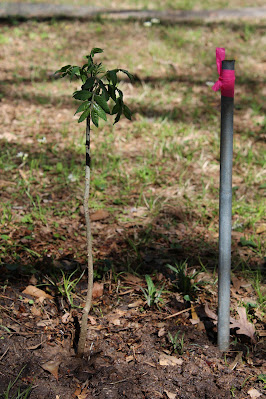Our early springtime weather has made tree planting an extra special joy. It's much more agreeable to dig in the dirt when it's 70 degrees and sunny, rather than 40 degrees and overcast. However, the trees planted this time of year are at a disadvantage. It would be best to allow the roots time to settle into their new soil and maybe start putting out new roots before spring weather arrives. Instead, as we see in the below photos, trees are already 'waking up' and rapidly expending their stored energy to make leaves, and it is surely traumatic to the organism to be uprooted at this time, as the root system is inevitably damaged during the moving process. So, for the good of the tree or shrub, those dreary January days in northwest Louisiana are best for transplanting because we cannot count on the plants to be dormant through February.
Now, let's be hopeful! Below, we have pictures of two recently transplanted toothache trees (Zanthoxylum clava-herculis). We collected both near the southwest corner of Mickle Hall, growing next to each other in a dewberry patch. One of the toothache trees is already in the arboretum catalogue; we discussed it in a previous blog post, found here. The other toothache marks a new entry into the arboretum catalogue. We relocated both trees to avoid certain death from planned construction work, but, in truth, the trees themselves did not choose a very good spot for germination—that dewberry patch at the top of a hill was much too dry. Now, the young toothache trees are growing in wetter conditions.
 |
This young toothache tree volunteered in the arboretum near the southwest corner of Mickle Hall. We don't know exactly when it germinated, but it must be less than three years old. Today, it is 18 inches tall. It is now growing in a partly sunny location, along the arboretum drainage channel, near the large Louisiana palmettos.
|
 |
The leaves appear to be drooping a little after the move. Interestingly, both toothache trees had shallow roots; there wasn't a difficult taproot to dig up.
|
 |
The other toothache tree is considerably taller, measuring 4 feet and 11 inches. This specimen entered the arboretum catalogue in December 2020. At that time, it measured less than 3 feet. It is now growing in full sun along the western drainage channel, near a salt matrimony vine (Lycium carolinianum) and a swamp dogwood (Cornus foemina).
|
 |
Unfriendly spines cover the thin trunk. Heavy gloves and caution are recommended for working with toothache trees.
|
 |
The leaves are also prickly! Handle with care!
|




